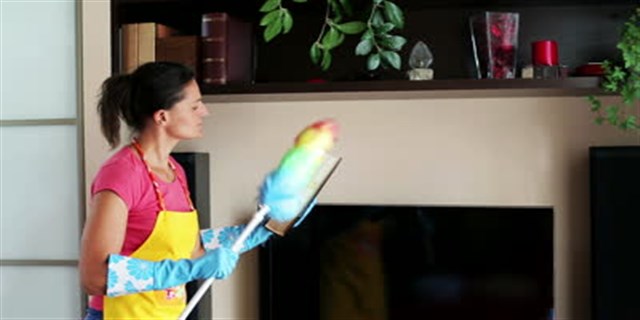Winter Cleaning
One of the things you will do to prepare your home for winter is general cleaning, Winter Cleaning. While it is not a matter of importance as much as spring cleaning, winter cleaning is one of the important jobs in the house. Now, we’re going to take a short look at the preparation of this work by separating into pieces. Let’s start with the first chapters:
Winter Cleaning: Walls and Ceilings:
Unless you live in a heavily polluted area or have a houseful of smokers, you do not need to clean your walls and ceilings more than once a year. Do not tackle more than a room at a time – this task is physically demanding.
Cleaning Non-washable Wallpaper
Dust non-washable wallpaper regularly to the wall. Sponge washable wall coverings with prevent dirt from building up. Never use a dish-washing liquid solution, working from water because it will loosen the paper from bottom to top. Rinse clean with warm water.
Winter Cleaning: Removing Marks
Rub marks with a scrunched up piece of crustless white bread, or an eraser. Rub gently to avoid damaging the wall covering – it may take several attempts before the marks begin to disappear.
Removing Grease Marks
Apply a warm (not hot) iron over the brown paper to absorb grease marks. Repeat using clean parts of the brown paper until all the grease is absorbed, then apply an aerosol grease solvent.
Washing Walls Down
Wash vinyl wall coverings occasionally, using a detergent solution applied on a sponge. Start from the bottom and work your way up, and rub gently so as not to damage the surface.
Patching Wallpaper
• Badly marked wallpaper may need to be patched rather than cleaned. Tear a matching piece, pulling away from you as you tear to create an uneven edge (which will show up less obviously than a cut edge).
• Stick the new patch into position with wallpaper paste, making sure that the pattern matches. If you are patching old wallpaper, leave the new piece in the sun to fade for a few days before patching.
Specialty Wall Coverings
• Grass-cloth cleans carefully since the grasses can come loose very easily. Simply dusting is sufficient – use a soft-brush vacuum-cleaner attachment on low suction. Be careful not to place furniture against grasscloth; it may rub the grasses loose and leave unsightly marks.
• Burlap paper: Dust regularly, using a vacuum- cleaner attachment. Dyes in burlap paper tend to run, so do not wet. Remove marks by rubbing with a piece of crustless white bread.
Painted Surfaces
Painted walls and ceilings can be kept in good condition for a long time with regular cleaning. But marks such as heavy tobacco stains can be difficult to eradicate. If this is a problem, redecorating may be a better solution than trying to scrub off the stains.
Ceilings
Cleaning: Do not wash ceilings – a fresh coat of paint is more effective. Dust with the improvised duster shown below, a long-handled brush, or the upholstery attachment on your vacuum cleaner.
Making a Ceiling Duster
Tie a clean dustcloth loosely around a broom head, and use to dust ceilings thoroughly from time to time. Remember to give the broom a shake at intervals.
Walls, Doors
• Cleaning walls: Use a warm solution of dishwashing liquid to clean walls. Do not stop in the middle of cleaning – you will create a tidemark that is difficult to remove. Wash one wall at a time completely.
Wall-Washing Method
Always start at the bottom of a wall and work upward. This may sound like extra work, but it is easier to wipe dirty trickles off a clean surface than off a dirty one.
Trimmings
• Very dirty walls: Clean with a solution of TSP (follow the manufacturer’s instructions for the strength of dilution) before using other cleaners.
• Doors and baseboards: Wash with a solution of dish-washing liquid (not detergent, which can affect paint color). Rinse with clear water, and pat dry.
Marks on Walls
• Tackling stains: Most marks come off painted walls but treat them gently to avoid damaging the paintwork. Rub fingerprints and pencil marks gently with an eraser. Wash food stains off with undiluted nonabrasive household cleaner. Where furniture has bumped into a wall and left a mark, try rubbing it out with an eraser first, then apply household cleaner as above.
Other Wall Types
Ceramic tiles often show dirt in the grouting between the tiles. Wood-paneled walls need frequent dusting (you can use your vacuum cleaner for this) and polishing once a year. Marks on bare brickwork are difficult to remove, so dust these walls frequently.
Ceramic Tile Walls
• Cleaning Grouting: Use an old, clean toothbrush dipped in a bleach solution to clean grouting between tiles. If the grout is filthy, it may be easier to apply new grouting.
Wood Paneling
• Removing polish: When the polish on wooden walls builds up, remove it using fine steel wool and turpentine. Rub gently but firmly, following the direction of the grain.
Brickwork
• Sealing brick walls: Apply a sealer to bare brickwork so that the brickwork will just require dusting and damp wiping. Use a soft paintbrush, and make sure the wall is clean.
Winter Cleaning: Windows
Dirty windows spoil the look of a home. Clean the outsides as often as necessary, depending on the area in which you live, and wash the insides two or three times a year. Do not forget to dust windows when you clean each room. Use a soft acrylic brush.
Washing Windows
• Homemade Cleaner: Make your own solution for washing windows by adding vinegar to water in a plant-spray bottle. Vinegar cuts grease and brings out the good shine.
Wiping Windows
• Using newspaper: Wipe newly washed windows clean with crumpled newspaper. This is a cheap alternative to a chamois leather, and the ink will give the glass an extra shine.
Timesaving Tip
• Protecting curtains: To avoid removing curtains when cleaning windows, loop them over a hanger.
Keeping Windows Smear Free
• Window-washing weather: Wash windows on cloudy days when they are damp and every fingerprint and mark show up. Sunny days are less ideal for window washing, since the windows dry too quickly, leaving smeary marks.
• Smear finder: When cleaning the outside and inside of a window, use horizontal strokes on one side and vertical strokes on the other. This way you can easily tell which side of the window still has the odd smear left.
Cleaning Mirrors
When cleaning mirrors, avoid using water, which can trickle down behind the glass and damage the silvering. Instead, use a commercial glass cleaner, then buff the mirror well.
Winter Cleaning: Electric Fixtures
Clean plastic wall outlets and light switches by wiping them with denatured alcohol on a clean cloth. Metal fixtures need the appropriate metal polish. Light bulbs should be dusted and cleaned regularly dirty bulbs can reduce lighting efficiency by up to 50 percent.
Cleaning Fixtures:
Using templates: To avoid getting cleaner or polish on walls when cleaning fixtures, make a template that fits around the fixture, and hold it in place during cleaning.
WARNING
Turn off electricity before cleaning electrical fixtures. Do not clean light bulbs while they.are in their sockets.
Treating Lightbulbs
• Lightbulbs: Before removing a lightbulb for cleaning, switch off the electricity. If the light has been on, wait for the bulb to cool down. Dry it thoroughly before replacing. Never use water on a bulb that is still in its socket.
• Scented bulbs: Wipe a little vanilla extract on the tops of lightbulbs with a soft cloth. When you turn on the lights, the scent will be released.
Cleaning lightbulbs
Hold lightbulbs by the base and carefully wipe over with a wrung-out damp cloth.
Winter Cleaning: Radiators and Heaters
Clean radiators once a week in winter and less often when not in use. Wipe with a dishwashing liquid solution and clean behind
Avoiding Problems
• Heating and air vents: These attract dust, so make sure that you catch them before they become clogged up. A bottle brush is the best way to remove grime as it builds up.
• Protecting flooring: Place a drop cloth under radiators during cleaning so dust and liquid do not fall on the floor.
• Marks above radiators: Rising hot air creates marks on walls above radiators. Installing shelves above radiators will help prevent this and will also direct heat into the room.
Cleaning Behind Radiators
Vacuum cleaning: Use the crevice tool of your vacuum cleaner to either suck or blow accumulated dust from behind radiators.
Improvised Brush
Cover a broom handle with a sponge, then an old sock. Use to clean behind radiators change the sock when it gets dirty.
Winter Cleaning: Fireplaces
An open fire is very cheerful, but fireplaces ingrained. Clean the fire surround thoroughly as unless you act before the soot becomes soon as the fireplace season is over.
Cleaning Chimneys
Wood burning chimneys: Have chimneys that are used to burn wood swept twice a year, as residue resin from the wood may catch fire.
Metal Parts: Polishing To clean the metal on fireplaces, use blacking or a commercial cleaner.
Applying blacking: Wearing gloves, apply blacking on a piece of steel wool. Polish the blacking with a soft cloth.
Clearing Grates
• Removing ashes: Remove coal ashes weekly, but leave wood ashes in the grate – they will act as a good base for your fire all winter.
Cleaning Surrounds
• Brick: Scrub well with a hard scrub brush and clean water. Sponge burn marks with vinegar, and rinse.
• Ceramic tile: Wash with a solution of dish-washing liquid or household detergent and rinse. Use a nonabrasive household cleaner on soot Marks.
• Marble: Sponge with a soap flake solution, then rinse and dry with an old towel. If polished, use a product specially designed for marble. Products are also available for repairing damaged marble.
Disposing of Ashes
Hot embers Always use a metal container when carrying ashes to the garbage bin, as any undetected hot embers will burn..
Traditional Tip
Making a scented fire: Throw pieces of dried citrus peel onto a fire to scent a room pleasantly. Pine-cones have the same effect.
Tip: Here, we’ve got some solution tips about winter cleaning. For more information, please click on the “tags” below.







